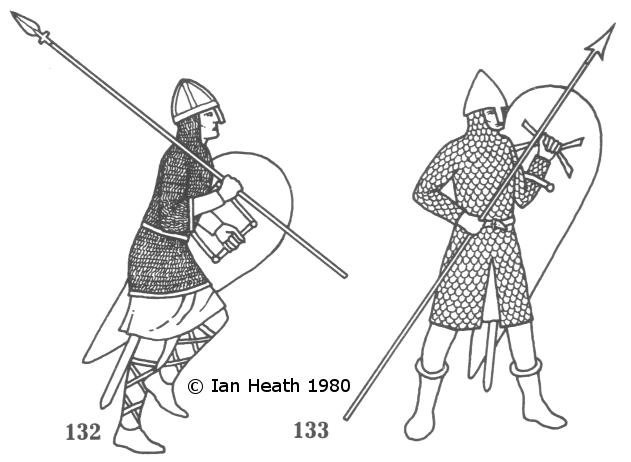11TH CENTURY EUROPEAN HEAVY INFANTRYMEN
An extract from Armies of the Dark Ages 600-1066by Ian Heath
 | |
| [c.f Saint Aubin defends Guérande, France, end of the 11th century] | [Based on the Bible of Saint Stephen Harding, France, 1109-11] |
 | |
| [c.f Saint Aubin defends Guérande, France, end of the 11th century] | [Based on the Bible of Saint Stephen Harding, France, 1109-11] |
132 & 133. 11TH CENTURY EUROPEAN HEAVY INFANTRYMEN
Chroniclers record heavy infantry to have fought at Hastings though none (other than the archer described in 129) are shown in the tapestry. Their equipment was identical to that of the knights, and indeed some at least may have been dismounted knights. However, contemporary sources, though conceivably exaggerating, record how helpless European knights generally were when dismounted so these were probably mercenaries who favoured foot-combat, perhaps Swabians, Old Saxons or other North Germans. Certainly if any were dismounted knights they would have been Normans or Frenchmen rather than Bretons, who seem to have depended so exclusively on cavalry that they probably were useless as infantry - there are certainly no records during this period or that immediately after of Bretons fighting on foot; a source of c. 1120 even records Bretons as being 7 times better fighting on horse than on foot.
These figures are based on French sources. 133 dates to 1110 but practically identical warriors appear in ms. illustrations from the early-11th century to the early-13th. His hauberk is coloured green in the original and probably represents horn scales. His shield is extremely large, almost the same length as his body.
Swabian mercenaries at the Battle of Civitate in 1053 fought mainly with double-handed swords, but the armoured infantry at Hastings were armed with javelins and spears.